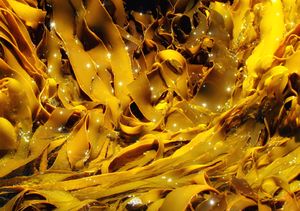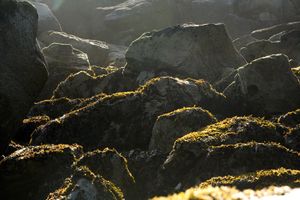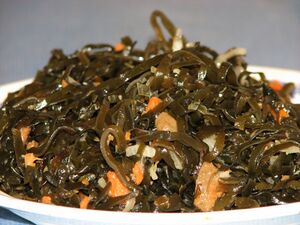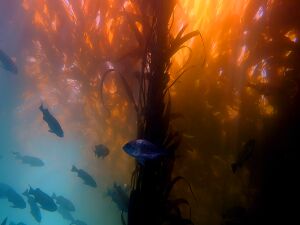طحالب صفحية
| الطحالب الصفحية Kelp | |
|---|---|

| |
| التصنيف العلمي | |
| مملكة: | |
| Phylum: | |
| Class: | |
| Order: | Laminariales |
| الفصائل | |
|
Akkesiphycaceae | |
الطحالب الصفحية Kelps، هي طحالب بحرية تنتمي إلى رتبة الطحالب البنية. يوجد منها 30 جنس مختلف.[بحاجة لمصدر]
تنمو الطحالب الصفحية في غابات تحت الماء (غابات الطحالب الصفحية) في المحيطات الضحلة، ويعتقد أنها ظهرت في العصر الميوسيني، منذ 23 إلى 5 مليون سنة مضت.[2] تحتاج هذه العضيات إلى مياه غنية بالمغذيات بدرجات حرارة تتراوح بين 6 و14 ° س. تشتهر بمعدلات نموها المرتفعة - جنس Macrocystis وNereocystis يمكنها النمو بمعدل نصف متر يومياً، لتصل في النهاية إلى ارتفاع 30-80 متر.[3]
Through the 19th century, the word "kelp" was closely associated with seaweeds that could be burned to obtain soda ash (primarily sodium carbonate). The seaweeds used included species from both the orders Laminariales and Fucales. The word "kelp" was also used directly to refer to these processed ashes.[4]
الوصف
In most kelp, the thallus (or body) consists of flat or leaf-like structures known as blades. Blades originate from elongated stem-like structures, the stipes. The holdfast, a root-like structure, anchors the kelp to the substrate of the ocean. Gas-filled bladders (pneumatocysts) form at the base of blades of American species, such as Nereocystis lueteana, (Mert. & Post & Rupr.)[3] to hold the kelp blades close to the surface.
| القيمة الغذائية لكل 100 g (3.5 oz) | |
|---|---|
| الطاقة | 180 kJ (43 kcal) |
9.57 g | |
| Sugars | 0.6 |
| ألياف غذائية | 1.3 g |
0.56 g | |
1.68 g | |
| الڤيتامينات | |
| ثيامين (B1) | (4%) 0.05 mg |
| ريبوفلاڤين (B2) | (13%) 0.15 mg |
| نياسين (B3) | (3%) 0.47 mg |
(13%) 0.642 mg | |
| فولات (B9) | (45%) 180 μg |
| Vitamin C | (4%) 3 mg |
| ڤيتامين E | (6%) 0.87 mg |
| ڤيتامين ك | (63%) 66 μg |
| آثار فلزات | |
| كالسيوم | (17%) 168 mg |
| حديد | (22%) 2.85 mg |
| الماغنسيوم | (34%) 121 mg |
| المنگنيز | (10%) 0.2 mg |
| فوسفور | (6%) 42 mg |
| پوتاسيوم | (2%) 89 mg |
| صوديوم | (16%) 233 mg |
| زنك | (13%) 1.23 mg |
| |
| Percentages are roughly approximated using US recommendations for adults. Source: USDA Nutrient Database | |
النمو والتكاثر
Growth occurs at the base of the meristem, where the blades and stipe meet. Growth may be limited by grazing. Sea urchins, for example, can reduce entire areas to urchin barrens.[5] The kelp life cycle involves a diploid sporophyte and haploid gametophyte stage. The haploid phase begins when the mature organism releases many spores, which then germinate to become male or female gametophytes. Sexual reproduction then results in the beginning of the diploid sporophyte stage, which will develop into a mature individual.
The parenchymatous thalli are generally covered with a mucilage layer, rather than cuticle.[6]
غابات الطحالب الصفحية
Kelp may develop dense forests with high production,[7] biodiversity and ecological function. Along the Norwegian coast these forests cover 5800 km2,[8] and they support large numbers of animals.[9][10] Numerous sessile animals (sponges, bryozoans and ascidians) are found on kelp stipes and mobile invertebrate fauna are found in high densities on epiphytic algae on the kelp stipes and on kelp holdfasts.[11] More than 100,000 mobile invertebrates per square meter are found on kelp stipes and holdfasts in well-developed kelp forests (Christie et al., 2003). While larger invertebrates and in particular sea urchins Strongylocentrotus droebachiensis (O.F. Müller) are important secondary consumers controlling large barren ground areas on the Norwegian coast, they are scarce inside dense kelp forests.[12]
الاستخدامات التجارية

Giant kelp can be harvested fairly easily because of its surface canopy and growth habit of staying in deeper water.
Kelp ash is rich in iodine and alkali. In great amount, kelp ash can be used in soap and glass production. Until the Leblanc process was commercialized in the early 19th century, burning of kelp in Scotland was one of the principal industrial sources of soda ash (predominantly sodium carbonate).[13] Around 23 tons of seaweed was required to produce 1 ton of kelp ash. The kelp ash would consist of around 5% sodium carbonate.[14]
Once the Leblanc Process became commercially viable in Britain during the 1820s, common salt replaced kelp ash as raw material for sodium carbonate. Though the price of kelp ash went into steep decline, seaweed remained the only commercial source of iodine. To supply the new industry in iodine synthesis, kelp ash production continued in some parts of West and North Scotland, North West Ireland and Guernsey. The species Saccharina latissima yielded the greatest amount of iodine (between 10 and 15 lbs per ton) and was most abundant in Guernsey. Iodine was extracted from kelp ash using a lixiviation process.[15] As with sodium carbonate however, mineral sources eventually supplanted seaweed in iodine production.[16]
Alginate, a kelp-derived carbohydrate, is used to thicken products such as ice cream, jelly, salad dressing, and toothpaste, as well as an ingredient in exotic dog food and in manufactured goods.[17][18][19] Alginate powder is also used frequently in general dentistry and orthodontics for making impressions of the upper and lower arches.[20] Kelp polysaccharides are used in skin care as gelling ingredients and because of the benefits provided by fucoidan.
Kombu (昆布 in Japanese, and 海带 in Chinese, Saccharina japonica and others), several Pacific species of kelp, is a very important ingredient in Chinese, Japanese, and Korean cuisines. Kombu is used to flavor broths and stews (especially dashi), as a savory garnish (tororo konbu) for rice and other dishes, as a vegetable, and a primary ingredient in popular snacks (such as tsukudani). Transparent sheets of kelp (oboro konbu) are used as an edible decorative wrapping for rice and other foods.[21]
Kombu can be used to soften beans during cooking, and to help convert indigestible sugars and thus reduce flatulence.[22]

In Russia, especially in the Russian Far East, and former Soviet Union countries several types of kelp are of commercial importance: Saccharina latissima, Laminaria digitata, Saccharina japonica. Known locally as "Sea Cabbage" (Морская капуста in Russian), it comes in retail trade in dried or frozen, as well as in canned form and used as filler in different types of salads, soups and pastries.[23]
Because of its high concentration of iodine, brown kelp (Laminaria) has been used to treat goiter, an enlargement of the thyroid gland caused by a lack of iodine, since medieval times.[24] An intake of roughly 150 micrograms of iodine per day is beneficial for preventing hypothyroidism. Overconsumption can lead to kelp-induced thyrotoxicosis.[25]
In 2010, researchers found that alginate, the soluble fibre substance in sea kelp, was better at preventing fat absorption than most over-the-counter slimming treatments in laboratory trials. As a food additive, it may be used to reduce fat absorption and thus obesity.[26] Kelp in its natural form has not yet been demonstrated to have such effects.
Kelp's rich iron content can help prevent iron deficiency.[27]
الانتاج التجاري
Commercial production of kelp harvested from its natural habitat has taken place in Japan for over a century. Many countries today produce and consume laminaria products; the largest producer is China. Laminaria japonica, the important commercial seaweed, was first introduced into China in the late 1920s from Hokkaido, Japan. Yet mariculture of this alga on a very large commercial scale was realized in China only in the 1950s. Between the 1950s and the 1980s, kelp production in China increased from about 60 to over 250,000 dry weight metric tons annually.
في التاريخ والثقافة
Some of the earliest evidence for human use of marine resources, coming from Middle Stone Age sites in South Africa, includes the harvesting of foods such as abalone, limpets, and mussels associated with kelp forest habitats.
In 2007, Erlandson et al. suggested that kelp forests around the Pacific Rim may have facilitated the dispersal of anatomically modern humans following a coastal route from Northeast Asia to the Americas. This "kelp highway hypothesis" suggested that highly productive kelp forests supported rich and diverse marine food webs in nearshore waters, including many types of fish, shellfish, birds, marine mammals, and seaweeds that were similar from Japan to California, Erlandson and his colleagues also argued that coastal kelp forests reduced wave energy and provided a linear dispersal corridor entirely at sea level, with few obstacles to maritime peoples. Archaeological evidence from California's Channel Islands confirms that islanders were harvesting kelp forest shellfish and fish, beginning as much as 12,000 years ago.
During the Highland Clearances, many Scottish Highlanders were moved on to areas of estates known as crofts, and went to industries such as fishing and kelping (producing soda ash from the ashes of kelp). At least until the 1840s, when there were steep falls in the price of kelp, landlords wanted to create pools of cheap or virtually free labour, supplied by families subsisting in new crofting townships. Kelp collection and processing was a very profitable way of using this labour, and landlords petitioned successfully for legislation designed to stop emigration. The profitability of kelp harvesting meant that landlords began to subdivide their land for small tenant kelpers, who could now afford higher rent than their gentleman farmer counterparts.[28] But the economic collapse of the kelp industry in northern Scotland during the 1820s led to further emigration, especially to North America.[بحاجة لمصدر]
Natives of the Falkland Islands are sometimes nicknamed "Kelpers".[29][30] This designation is primarily applied by outsiders rather than the natives themselves.
In Chinese slang, "kelp" (الصينية المبسطة: 海带; الصينية التقليدية: 海帶; پنين: hǎi dài), is used to describe an unemployed returnee.قالب:Huh It has negative overtones, implying the person is drifting aimlessly, and is also a homophonic expression (الصينية: 海待; پنين: hǎidài, literally "sea waiting"). This expression is contrasted with the employed returnee, having a dynamic ability to travel across the ocean: the "sea turtle" (الصينية المبسطة: 海龟; الصينية التقليدية: 海龜; پنين: hǎi gūi) and is also homophonic with another word (الصينية المبسطة: 海归; الصينية التقليدية: 海歸; پنين: hǎi gūi, literally "sea return").
الحفاظ
أنواع شهيرة
التفاعل
معرض الصور
Giant kelp in the Monterey Bay Aquarium.
A view of the Kelp Forest Exhibit at the Monterey Bay Aquarium from the upstairs level.
A close up view of Ecklonia maxima Giant Brown Kelp
Saccharina latissima in salad form, same also in canned form
انظر أيضاً
المصادر
- ^ Migula, W. (1909). Kryptogamen-Flora von Deutschland, Deutsch-Österreich und der Schweiz. Band II. Algen. 2. Teil. Rhodophyceae, Phaeophyceae, Characeae. Gera: Verlag Friedriech von Zezschwitz. pp. i–iv, 1–382, 122 (41 col.) pls.
- ^ Macrocystis Evolution
- ^ أ ب Thomas, D. 2002. Seaweeds. The Natural History Museum, London, p. 15. ISBN 0-565-09175-1
- ^ "Kelp," in Oxford English Dictionary (Second Edition). Oxford University Press, 1989. Retrieved 1 December 2006
- ^ Norderhaug, KM., Christie, H. 2009. Sea urchin grazing and kelp re-vegetation in the NE Atlantic. Marine Biology Research 5: 515-528. Estuarine, Coastal and Shelf Science 95: 135-144
- ^ Fritsch, F. E. (1945). Structure and Reproduction of the Algae, Volume 2. Cambridge University Press. p. 226. ISBN 9780521050425. OCLC 223742770.
- ^ Abdullah, M.I., Fredriksen, S., 2004. Production, respiration and exudation of dissolved organic matter by the kelp Laminaria hyperborea along the west coast of Norway. Journal of the Marine Biological Association of the UK 84: 887.
- ^ Rinde, E., 2009. Dokumentasjon av modellerte marine Naturtyper i DNs Naturbase. Førstegenerasjonsmodeller til kommunenes startpakker for kartlegging av marine naturtyper 2007. NIVA report, 32 pp.
- ^ Christie, H., Jørgensen, N.M., Norderhaug, K.M., Waage-Nielsen, E., 2003. Species distribution and habitat exploitation of fauna associated with kelp (Laminaria hyperborea) along the Norwegian coast. Journal of the Marine Biological Association of the UK 83, 687-699.
- ^ Jørgensen, N.M., Christie, H., 2003. Follow me @radd.michyy and lowk3y.nadine l Diurnal, horizontal and vertical dispersal of kelp associated fauna. Hydrobiologia 50, 69-76.
- ^ Norderhaug, K.M., Christie, H., Rinde, E., 2002. Colonisation of kelp imitations by epiphyte and holdfast fauna; a study of mobility patterns. Marine Biology 141, 965-973.
- ^ Norderhaug, K.M., Christie, H., 2009. Sea urchin grazing and kelp re-vegetation in the NE Atlantic. Marine Biology Research 5, 515-528.
- ^ Clow, Archibald; Clow, Nan L. (1952). Chemical Revolution. Ayer Co Pub. pp. 65–90. ISBN 978-0-8369-1909-7. OCLC 243798097.
- ^ Jonathan Pereira, Fred B. Kilmer, The Elements of Materia Medica and Therapeutics, Volume 1, 1854, p. 558
- ^ Edward C. C. Stanford, Wentworth L. Scott, ‘The Economic Applications of Seaweed’, February 14 1862, Journal of the Royal Society of Arts, Vol 10, No. 482, 185-199
- ^ John J. McKetta Jr. Taylor & Francis, Encyclopaedia of Chemical Processing and Design: Volume 27 - Hydrogen Cyanide to Ketones Dimethyl (Acetone), 1988, p. 283
- ^ Brownlee, Iain A.; Seal, Chris J.; Wilcox, Matthew; Dettmar, Peter W.; Pearson, Jeff P. (2009), Rehm, Bernd H. A., ed. (in en), Applications of Alginates in Food, Microbiology Monographs, Springer Berlin Heidelberg, pp. 211–228, doi:, ISBN 9783540926795, https://www.researchgate.net/publication/225729229, retrieved on 2019-01-25
- ^ Uzunović, Alija; Mehmedagić, Aida; Lačević, Amela; Vranić, Edina (2004-11-20). "Formulation ingredients for toothpastes and mouthwashes". Bosnian Journal of Basic Medical Sciences (in الإنجليزية الأمريكية). 4 (4): 51–58. doi:10.17305/bjbms.2004.3362. ISSN 1840-4812. PMC 7245492. PMID 15628997.
- ^ Rychen, Guido; Aquilina, Gabriele; Azimonti, Giovanna; Bampidis, Vasileios; Bastos, Maria de Lourdes; Bories, Georges; Chesson, Andrew; Cocconcelli, Pier Sandro; Flachowsky, Gerhard (2017). "Safety and efficacy of sodium and potassium alginate for pets, other non food-producing animals and fish". EFSA Journal (in الإنجليزية). 15 (7): e04945. doi:10.2903/j.efsa.2017.4945. ISSN 1831-4732. PMC 7009951. PMID 32625597.
- ^ Powers, John M. Powers. Craig's Restorative Dental Materials, 12th Edition. C.V. Mosby, 022006. p. 270
- ^ Kazuko, Emi: Japanese Cooking, p. 78, Hermes House, 2002, p. 78. ISBN 0-681-32327-2
- ^ Graimes, Nicola: The Best-Ever Vegetarian Cookbook, Barnes & Noble Books, 1999, p. 59. ISBN 0-7607-1740-0
- ^ "Features of the Far Eastern cuisine". www.eastrussia.ru. Retrieved 2021-01-14.
- ^ Iodine Helps Kelp Fight Free Radicals and May Aid Humans, Too Newswise, Retrieved on July 8, 2008.
- ^ Leung, Angela M.; Braverman, Lewis E. (March 2014). "Consequences of excess iodine". Nature Reviews Endocrinology (in الإنجليزية). 10 (3): 136–142. doi:10.1038/nrendo.2013.251. PMC 3976240. PMID 24342882.
- ^ "Is Seaweed The Answer To A Dieter's Prayer?". Sky News. March 22, 2010. Archived from the original on March 25, 2010. Retrieved March 23, 2010.
- ^ Miller, Eric P.; Auerbach, Hendrik; Schünemann, Volker; Tymon, Teresa; Carrano, Carl J. (20 April 2016). "Surface binding, localization and storage of iron in the giant kelp Macrocystis pyrifera". Metallomics (in الإنجليزية). 8 (4): 403–411. doi:10.1039/C6MT00027D. ISSN 1756-591X. PMID 27009567.
- ^ J. M. Bumsted, The People's Clearance: Highland Emigration to British North America, 1770-1815, 1981
- ^ [1] allwords.com definition for "Kelper",
- ^ [2] dictionary.com definition for "Kelper"
قراءات إضافية
- Druehl, L.D. 1988. Cultivated edible kelp. in Algae and Human Affairs. Lembi, C.A. and Waaland, J.R. (Editors) 1988.ISBN 0 521 32115 8.
- Erlandson, J.M., M.H. Graham, B.J. Bourque, D. Corbett, J.A. Estes, & R.S. Steneck. 2007. The Kelp Highway hypothesis: marine ecology, the coastal migration theory, and the peopling of the Americas. Journal of Island and Coastal Archaeology 2:161-174.
وصلات خارجية
- CS1 الإنجليزية الأمريكية-language sources (en-us)
- Articles with unsourced statements from November 2010
- مقالات ذات عبارات بحاجة لمصادر
- Articles containing simplified Chinese-language text
- Articles containing traditional Chinese-language text
- Articles containing Chinese-language text
- طحالب صفحية
- Edible seaweeds
- أعشاب بحرية












